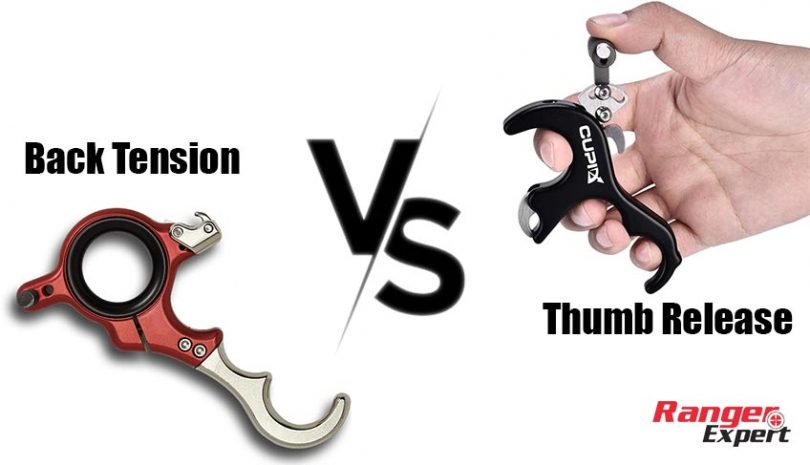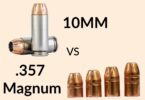Among the different archery releases, back tension release for hunting and archery is the most popular across the world.
Thumb releases are similar to back tension in that they are specially designed so that you can hold at full draw. It also gives you free will to have your thumb around the trigger and pull it gradually.
Back tension and thumb releases are undoubtedly similar in several ways. As such, this article will examine what separates a back tension release from a thumb release.
We’ll answer questions like “how does a back tension release work? How does a thumb release work? What are the key differences between them? And how can you choose the best one for yourself?”
Let’s dive into our in-depth “back tension vs thumb release” comparison guide to explore more.

Back tension release relies on a consistent & precise amount of pressure to ensure accuracy. Here, you use your hand to create a smooth pullback motion & put all the attention on your back. Thumb releases, on the other hand, involve using your thumb to push a button/lever that triggers the arrows to be released, without putting tension on your back.
Let’s explore more in the sections below.
Back Tension vs Thumb Release – Key Differences
Design and Material
The first key difference in our “thumb release vs back tension release” guide is their design and material used.
There are several ways to identify both releases, especially by their design and material. The back tension release comes mainly with a hinge and lacks traditional triggers, which leaves the archer with no other option than to rely on back tension to fire.
A thumb release has a trigger but comes in a different design that allows you to hold the bow, whether a compound bow or even a crossbow, at full draw. This opens you up to be able to wrap your thumb around the trigger, letting you pull back quickly and carefully as you aim.
Types/Variations
The back tension releases are of two types. First, we have the hinge releases in which the hand as a whole serves the purpose of a trigger and as a sear that ensures that the hook and D-loop are in place.
Then, the tension-activated release requires you to pull through the shot to set it off by putting more pressure between the release head and the edge of the bowstring until you fire.
On the other hand, modern thumb releases come in various forms, including the general thumb release, which most archers are familiar with, where the bow is stretched off by the thumb creating space for it to be wrapped around the trigger.
Then we have the thumb trigger release, which comes with a small trigger release that reduces panicking.
Mechanisms
The thumb release technique works in a very easy-to-understand way as it is activated by pulling the trigger, using the thumb, and aiming at the desired target. It comes with closed jaw clasps that make it mobile for use.
The D-loop connects well with the hook making it easy to draw back for longer throws.
The physics of archery and the mechanism of back tension release differs slightly from that of thumb release, based on the type. For the tension-activated release, the pressure is placed between the areas of the release head and bowstring.
This pressure mount differs based on the strength of the archer and determines what the weight of the fire would be like
Efforts Required for Adjustment
The efforts required to adjust both the thumb and back tension release also differ. Let’s quickly see how we can adjust both releases.
How Can You Adjust a Back Tension Release?
The efforts required to adjust Back tension releases which include both the hinge as well as the tension-activated releases, come in different finger models.
The difference in finger models determines the number of fingers required when firing and how it can be adjusted. While it is possible to adjust the back tension release, you also need to put a lot of effort into adjusting yourself. Both the thumb and back tension release also differ. Let’s quickly see how we can adjust both releases.
How Can You Adjust a Thumb Release?
Since the hook of a thumb release connects with D-loop with both in place by the sear, to adjust a thumb release, you would need to adjust the sear.
When you adjust the sear, the hook and the D-loop will also be adjusted and firm to either increase the shot range or decrease it. The lighter the sear is, the longer your throw is likely to become, and vice versa.
Usability
The hinge vs thumb release and its usability have many questions surrounding it as archers need clarification with both at several points.
The back tension release is less common than the thumb release and is suitable for new archers. This happens mainly because they are still at the stage where they anticipate shots with their instincts and hunting release.
Archers would not have to worry about flinching with the back tension release. Also, this is best for new archers because it has a safety feature that allows them to control their firing.
Thumb releases, however, are best for archers more interested in target archery and hunting. It is designed in such a way that a bit of body control and adjustment leaves you hiring your target.
However, you’ll have to know more about its adjustability, tension, travel, and location to do this.
Advantages
Back tension releases come with several advantages over thumb releases, including their relative affordability, ease of use, and depth of impact on targets.
It also incorporates certain safety features so that the archer would not have to hurt himself while aiming at and firing the target.
Thumb releases, on the other hand, have their advantages too. First, they have proven to be one of the best and most widely used releases. They also have easy-to-use and comfortable anchor points that make it easy to aim at the target.
It also comes in handy sizes and allows you to use your draw hand for other activities or keep them in your pockets during the cold.
Disadvantages
Thumb releases can handle their setbacks. Among other things, they are costly when compared to the back tension releases alone but also when compared to other releases.
Target panic release is also one disadvantage of thumb release, especially among new archers who have little knowledge of it. The back tension release is also not fleeting in that it requires a lot of practice sessions to master it.
The inability to understand this type of release might be fatal when aiming at a target. You might get caught up in the whole process of getting things done that you will end up missing your target.
Archery feels best when you can constantly get on the field and hit your target accurately. However, an understanding is needed as to what releases are and which is best for you.
In this “back tension vs thumb release” comparison guide, I trust you have been able to see the difference and the relationship between them.
You now also have a better understanding of their usability. The more knowledge you get about archery, the better archer you become over time.
Final Thoughts
It is crucial to keep in mind that the type of release you use to shoot your arrows will drastically affect the accuracy, range, and feel of your shots.
The back tension release provides a consistent feel and makes it easier for archers to learn the correct shooting form. It also comes with safety features which is beneficial for new archers who are still learning the ropes.
The thumb release is best for experienced archers looking to hit their targets accurately over a long range. It also allows the users to easily adjust tension, travel, and other settings, enhancing accuracy even further.
When you understand your releases better, you can make better decisions regarding shooting arrows in any situation.
So, understanding both types of releases is essential if you want to become a better archer. The choice between back tension and thumb releases should ultimately come down to personal preference and shooting style. Whichever fits your needs best is the perfect release for you!
With this, we conclude our “back tension release vs thumb release” comparison. Hopefully, you’ll find helpful information and choose the perfect release for you. Thanks for reading this far. Happy Shooting!
FAQs
Which Type of Release Is Better for Accuracy?
The back tension release is often associated with more accuracy. That’s because it encourages consistency in form throughout the shot cycle, making it less likely that a mistake will be made. On the other hand, the thumb release can provide more precision when aiming if you can effectively use the trigger finger.
Do I Need Special Equipment if I Switch From One Style to Another?
Suppose you currently use a back tension release but want to transition to a thumb release. In that case, you will need to purchase a new bow, arrows, and quiver since the back tension style requires special equipment. However, switching from a thumb release to a back tension release, you will only need to purchase the back tension release itself.
Are There Any Drawbacks to Using either Style of Release Technique?
Back tension releases can be challenging to master, as they require high coordination between muscles and timing. On the other hand, thumb releases may not provide the same level of accuracy or precision as back tension releases when shooting at longer distances.









Leave a Comment